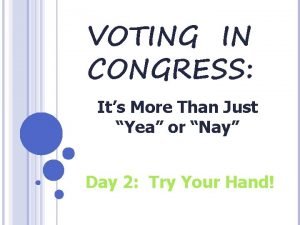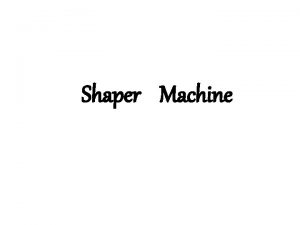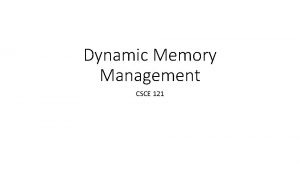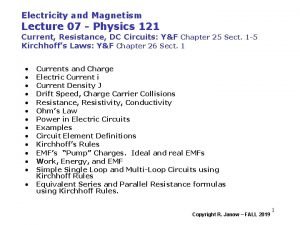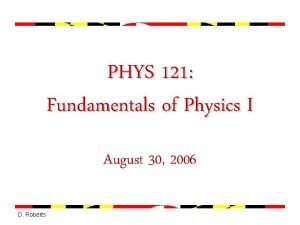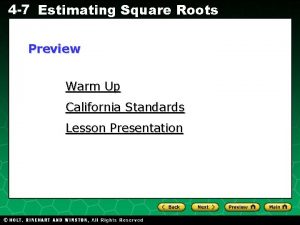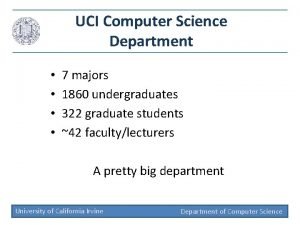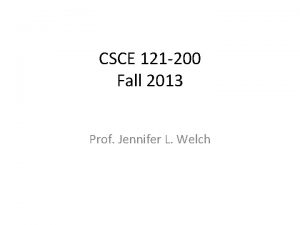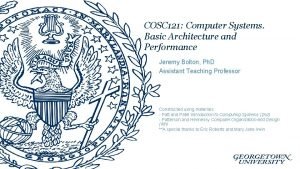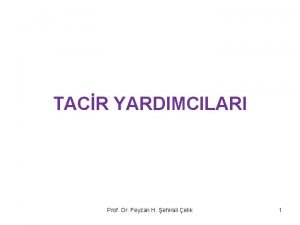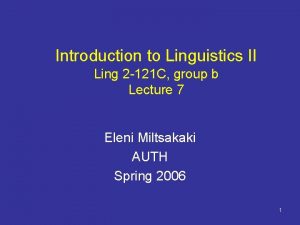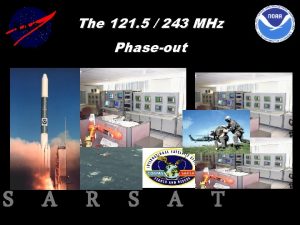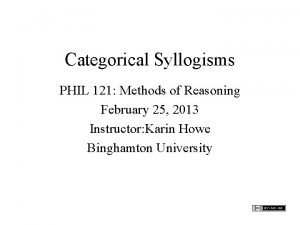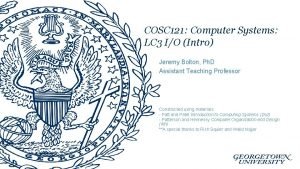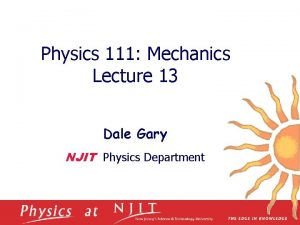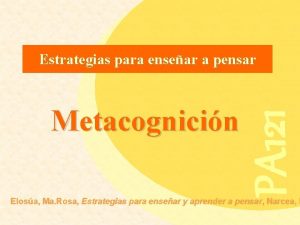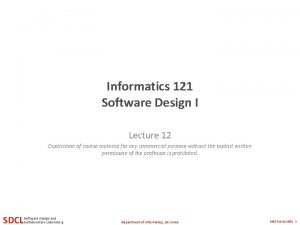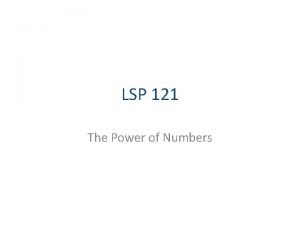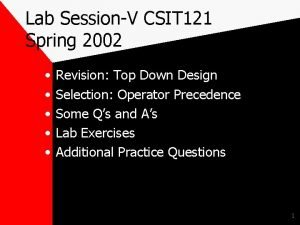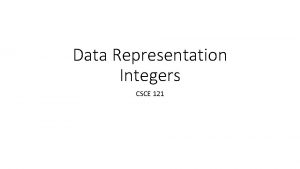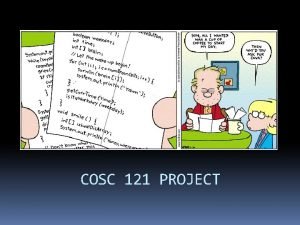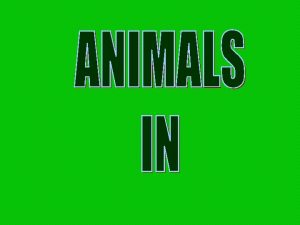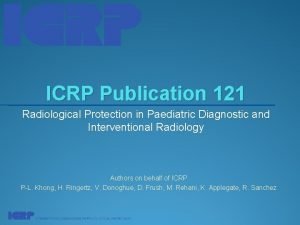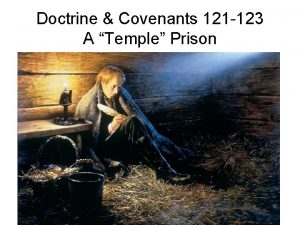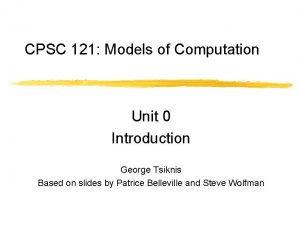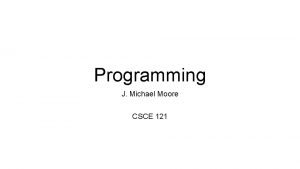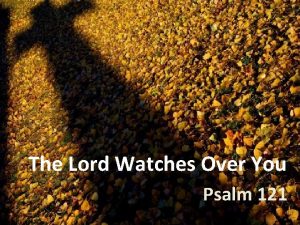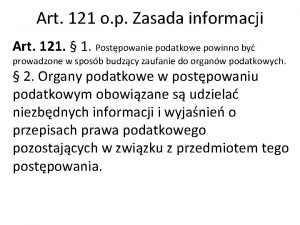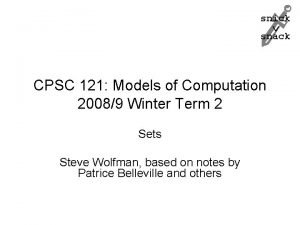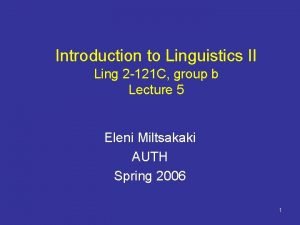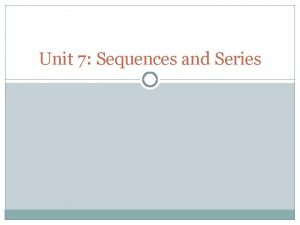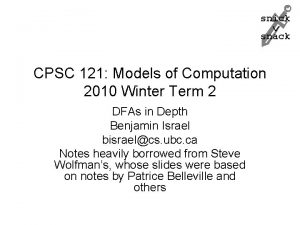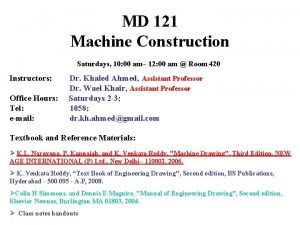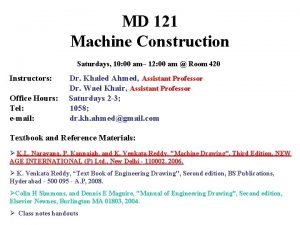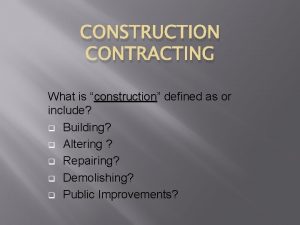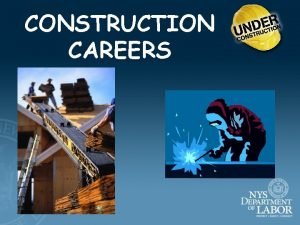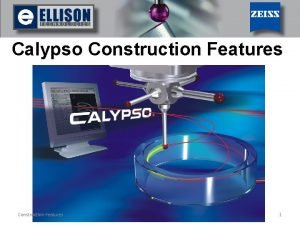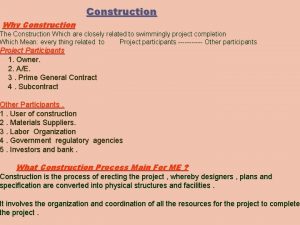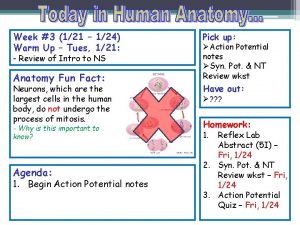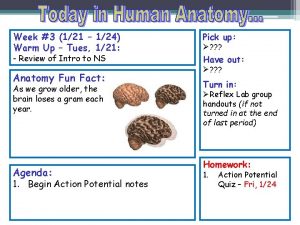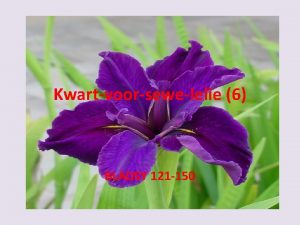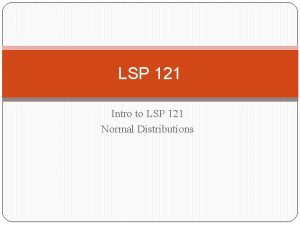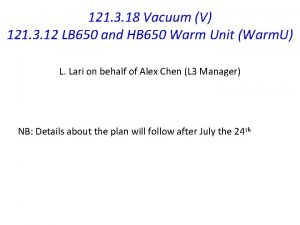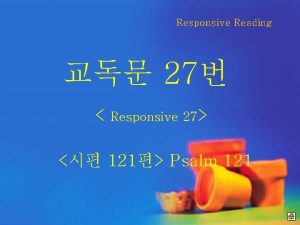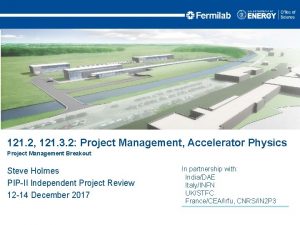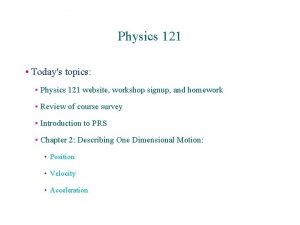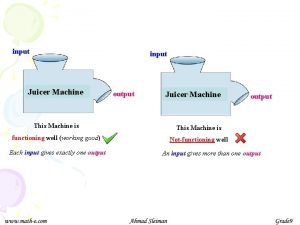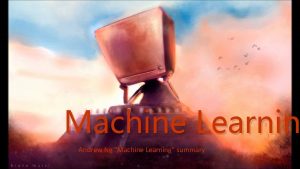MD 121 Machine Construction Saturdays 10 00 am













































- Slides: 45

MD 121 Machine Construction Saturdays, 10: 00 am– 12: 00 am @ Room 420 Instructors: Office Hours: Tel: e-mail: Dr. Khaled Ahmed, Assistant Professor Dr. Wael Khair, Assistant Professor Saturdays 2 -3; 1058; dr. kh. ahmed@gmail. com Textbook and Reference Materials: Ø K. L. Narayana, P. Kannaiah, and K. Venkata Reddy, "Machine Drawing", Third Edition, NEW AGE INTERNATIONAL (P) Ltd. , New Delhi - 110002, 2006. Ø K. Venkata Reddy, “Text Book of Engineering Drawing", Second edition, BS Publications, Hyderabad - 500 095 - A. P, 2008. ØColin H Simmons, and Dennis E Maguire, "Manual of Engineering Drawing", Second edition, Elsevier Newnes, Burlington MA 01803, 2004. Ø Class notes handouts

Intended Learning Outcomes (ILO’s) Knowledge and Understanding: You will learn how to; Ø Understand the basic methods for machine assembly Ø Distinguish between the data and instructions used for both working and assembly drawings Ø Professionally deduce and sketches both working and assembly drawings according to the international standards Intellectual You will learn how to; Ø Motivate your intellectual abilities to imagine and deduce machine parts and a whole machine from the drawings views. Ø Motivate your imagination for producing new ideas and methods in machine drawings. Ø Create new concepts for the design of machine components and also for assembly of them. Professional Skills You will learn how to; Ø Practice the standard drawing methods to generate both working and assembly mechanical drawings. Ø Write and specify correctly and according to standards the instructions and machining marks and the dimensions on mechanical drawings. General You will learn how to; Ø Cooperate to work in groups through small scale projects Ø Work coherently and successfully as a part of a team.

Course Outline Topic Weeks 1. Revision Chapters (1 -4) 1 2. Reading A Drawing Chapter (17) 1 3. Free Hand Sketching Chapter (13) 1 4. Assembly Drawings Chapter (18) 1 5. Fits and Dimensional Tolerances Chapter (15) 1 6. Geometrical Tolerances Chapter (20) 2 7. Engineering Materials Collections 1 8. Working Drawings Chapter (19 -20) 1 9. Mechanical Joints (1 - Threaded Joints) Chapter (5) 3 10. Machine Parts Collections 2 Total 14 Ø Problems Sheets will be handed in the class after discussed in the lecture Ø An extra class will be given to students with Mark “C” every next Saturday Ø A term project will be given by Dr. Wael and will be submitted at the end of the term

Course Assessment and Evaluation We shouldn’t learn to get marks We shouldn’t learn to get certificates We shouldn’t learn to get titles Ø Why do we learn? Ø To gain knowledge Ø To achieve objectives Ø To build career Ø Why do we need assessment and evaluation? Ø To measure the achieved objectives Ø To point out what in need for improvements Class Work …………………………. . Extra Class Work (Mark “C” students will get bonus) ……. . Course Project ………………… 10% 10% Lecture Quizzes ……………. . ………………… Mid Term (November 27 th 2010)……………… 5% 10% Final Exam (Sit in Exam)…………………… 65%

Revision

How to Keep Your Drawing Clean Do Don’t

Drawing Sheet Size Assembly Drawing Working Drawing

Types of lines and their applications

Types of lines and their applications

Types of lines and their applications

PROJECTION SYSTEMS

PROJECTION SYSTEMS 1. First angle system - European country - ISO standard First Quadrant 2. Third angle system - Canada, USA, Japan, Thailand Third Quadrant

ORTHOGRAPHIC PROJECTION 1 st angle system 3 rd angle system

ORTHOGRAPHIC VIEWS 3 rd angle system 1 st angle system Folding line

ORTHOGRAPHIC VIEWS 1 st angle system Right Side View Front View Top View 3 rd angle system Top View Front View Right Side View

PROJECTION SYMBOLS First angle system Third angle system

Quick Quiz

3. Which is in correct first angle projection ? (180 sec) a) b) c) d) 0 45 90 135 180

4. Which is in correct third angle projection ? (180 sec) a) b) c) d) 0 45 90 135 180

5. Which is a wrong 3 rd angle orthographic views ? (180 sec) a) b) c) d) 0 45 90 135 180

VIEW SELECTION STEPS 1. Orient the object to the best position relative to a glass box. 2. Select the front view. 3. Select adjacent views.

STEP 1 : Orient the Object The object should be placed in its natural position. The object should presents its features in actual size and shape in orthographic views. GOOD NO !

STEP 2 : Select a Front View The object’s longest dimension should be presented as a width. First choice Second choice Waste more space Inappropriate GOOD

STEP 2 : Select a Front View The adjacent views that are projected from the selected front view should appear in its natural position. Inappropriate

STEP 2 : Select a Front View Choose the view that have the fewest number of hidden lines. GOOD Inappropriate

STEP 3 : Select an Adjacent View Choose the view that have the fewest number of hidden lines. GOOD Inappropriate

STEP 3 : Select an Adjacent View Choose the minimum number of views that can represent the major features of the object. Necessary Hole’s location can be specified on the same view. Easy to understand Difficult to interprete. Necessary

STEP 3 : Select an Adjacent View Choose the views that are suitable to a drawing space. POOR Not enough space for dimensioning.

STEP 3 : Select an Adjacent View Choose the views that are suitable to a drawing space. GOOD

D Example : View selection H mislead to… W F. V. D Size description Shape description H W F. V. & T. V. Three views F. V. & R. S. V.

ONE-VIEW DRAWING Flat part having a uniform thickness. 1 Thick Unnecessary These 2 views provide only information about the part thickness !

ONE-VIEW DRAWING Cylindrical-shaped part. Unnecessary Repeat ! Infer from CL Unnecessary

TWO-VIEW DRAWING There exists an identical view. Repeat ! Unnecessary

TWO-VIEW DRAWING The 3 rd view has no significant contours of the object. Unnecessary

TWO-VIEW DRAWING The 3 rd view has no significant contours of the object. Unnecessary

Quick Quiz

1. Which should be the natural position of the light bulb ? (20 sec) a b) c) d) 0 5 10 15 20

2. Which are the necessary views ? (60 sec) a) A-C-E E D b) E-B-D B c) E-A d) E-C A 0 15 30 45 60 C F

Projection

Projection

Projection

Quick Quiz

Projection B(FV) B(SV) A(TV) D(FV) C(SV) A(FV) C(FV) D(SV)

Drawing Reading

Drawing Reading Rear tool post is generally used on capstan lathes, mainly for parting-off operations. It is fixed on the cross-slide in the slots, provided at the rear side of the lathe
 Does ups deliver on saturdays
Does ups deliver on saturdays Bill a no mail on saturdays worksheet answers
Bill a no mail on saturdays worksheet answers What do you usually do on saturdays
What do you usually do on saturdays In shaper job is kept
In shaper job is kept Moore machine
Moore machine Chapter 10 energy, work and simple machines answer key
Chapter 10 energy, work and simple machines answer key Finite state machine vending machine example
Finite state machine vending machine example Mealy or moore machine
Mealy or moore machine Csce 121 tamu
Csce 121 tamu Is 121
Is 121 The leftovers question 121
The leftovers question 121 Phys 121 umd
Phys 121 umd In4matx 121
In4matx 121 Lmt100 ifm
Lmt100 ifm Psal 121
Psal 121 Simplify square root of 185
Simplify square root of 185 Uci ics specialization
Uci ics specialization Csce 121
Csce 121 Dr junaid ahmed
Dr junaid ahmed Cosc 121
Cosc 121 Simsar nedir ttk
Simsar nedir ttk Semantic anomaly
Semantic anomaly 121,5 mhz
121,5 mhz Syllogism examples
Syllogism examples Cosc 121
Cosc 121 Kepler njit
Kepler njit Metacognicin
Metacognicin Inf 121 uci
Inf 121 uci Ordinal numbers 121
Ordinal numbers 121 Csit 121
Csit 121 Základní jednotky si
Základní jednotky si 121 to binary
121 to binary Cosc 121
Cosc 121 Look at the photo and answer the questions
Look at the photo and answer the questions Icrp 121
Icrp 121 Doctrine and covenants 121-123
Doctrine and covenants 121-123 Ubc cpsc 121
Ubc cpsc 121 Lmt 121
Lmt 121 Csce 121
Csce 121 He watches over you
He watches over you Art 121 op
Art 121 op Cpsc 121
Cpsc 121 Phy 121 asu
Phy 121 asu Words that are spelled the same but pronounced differently
Words that are spelled the same but pronounced differently Nth term of ap
Nth term of ap Cpsc 121 ubc
Cpsc 121 ubc

